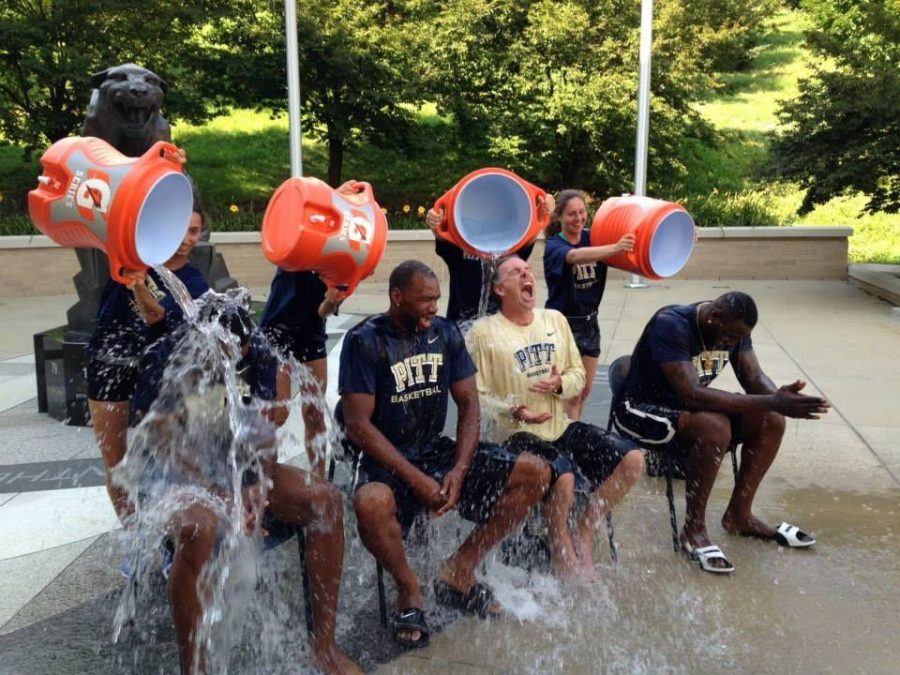Hashtag Activism: There’s more to charity than ice buckets
August 27, 2014
Charities and ice-cold water are no strangers to each other.
The ALS Association — a nonprofit organization that raises money and promotes awareness of amyotrophic lateral sclerosis, a neurodegenerative disease — adapted the Ice Bucket Challenge from a previous social media trend, the Cold Water Challenge, during which individuals challenged each other to jump into semi-frozen bodies of water or to opt out and donate to cancer research. The trend went viral and challenges escalated until the craze abruptly ended in May 2014 when a 16-year-old accepted the challenge to jump into Minnesota’s Eagle Lake and never resurfaced.
While the ALS Association has made efforts to minimize injury and death — restricting the challenge to dumping a bucket of ice water on one’s head — it has solidified an even greater threat: “slacktivism.”
Slacktivism, according to Washington Post writers, Huffington Post bloggers and other reliable online resources, such as Urban Dictionary and Wikipedia — and, for the academics among you readers, the Oxford English Dictionary concurs — is the combination of the words “slacker” and “activism.” The term is used, with negative connotation, to describe actions via social media that require little time or economic involvement and claim to “support” political and social causes.
The problem with the #IceBucketChallenge and previous other viral attempts to raise awareness and money for global issues, such as #BringBackOurGirls and #StopKony, is that they, like many other trends weaved with social media, promote a superficial and society-wide façade.
As of Aug. 25, the Ice Bucket Challenge has raised $79.7 million. It would seem, then, that the Ice Bucket Challenge was successful. However, it was the ALS Association’s goal to not only raise money but to spread awareness about the disease as well. Where are the reports and headlines about that?
People are more interested in participating in the latest social media fad than they are about giving to charity, and the viral nature of these campaigns reaffirms that posting a video of yourself dumping ice water on your head or reposting the Kony video in 2012 counts as charity and activism. It inflates the sense that you are helping, that you are giving back and that you are making a difference.
Keep in mind that many people posting the videos are dousing themselves in ice water instead of donating money. In fact, those people are supporting the water companies more than anything else.
“You’ve internally placed a monetary value on the cost of goods, the time spent and for posting on your social channels. This monetary value has little long-term effect and, next time you’re thinking of donating to a charity or for a cause, you might think back to that time you created a video,” wrote Ben Kosinski for the Huffington Post.
This new global marketing scheme might receive a lot of attention. It might even raise millions of dollars. But, in the end, it attracts participants who are looking to conform to the latest fad and acquire Facebook likes and retweets along the way. No doubt social media can be a great avenue for education, but #StopKony, #BringBackOurGirs and #IceBucketChallenge are tied to going viral.
If the ALS Association benefits and participants are getting social media highs, isn’t it a win-win?
The ALS Ice Bucket Challenge points to a larger problem with contemporary charity and activism — it involves giving people money, being satisfied you’ve done something and moving on with your life. It is superficial and lazy.
To me, charity has always been a hands-on, face-to-face interaction — playing Bingo with local nursing home residents, visiting patients in hospice care and teaching Spanish-speaking adults how to speak and write English. It is also self-initiated. I don’t do charity work simply because someone nominated me to do it or because, if I don’t participate, I’ll be left out.
Participants in the ALS Ice Bucket Challenge are missing out on the satisfaction of knowing they changed someone’s life or simply made a few minutes of their day better.
What happens when the Ice Bucket Challenge craze ends and the money raised is used up? Will the ALS Ice Bucket Challenge be a recurring fad? Have recurring fads ever happened before? A few years from now, when research has gotten much closer to a cure but hasn’t quite grasped one — because finding cures is painstakingly slow — and the ALS Association finds itself again with no support and no funding, Facebook and Twitter users won’t be easily excited because the Ice Bucket Challenge will, by then, be a “been there, done that” fad.
Simply put, the participants lose the satisfaction that real charity provides, and the ALS Ice Bucket Challenge is a one-time, unsustainable deal. Even though a lot of money has been raised and much attention has been given, a price cannot be put on the value of personal, genuine service towards such a cause.
Social media and the Internet have made our lives easier — one click and you’ve purchased a house. One status update and the whole world knows you’re “In a Relationship.” One video post goes viral and a new singer becomes famous. But, in this simplified, viral world, there are still patients and people out there who need the same charity and volunteer aid that they did 100 years ago. The ALS Ice Bucket Challenge is not directly taking this away from patients, but rather indirectly putting the focus on impersonal measures instead of in-person care.
Remember what giving back really means, even if it takes up more of your time and is rewarded with gratitude and joy rather than likes and retweets.
Write to Jess at [email protected]



